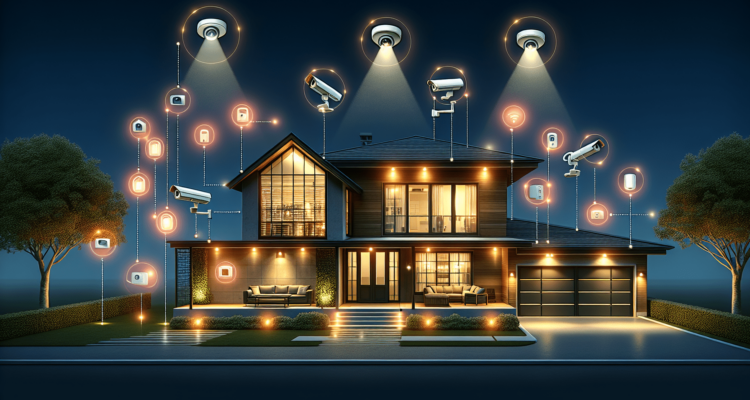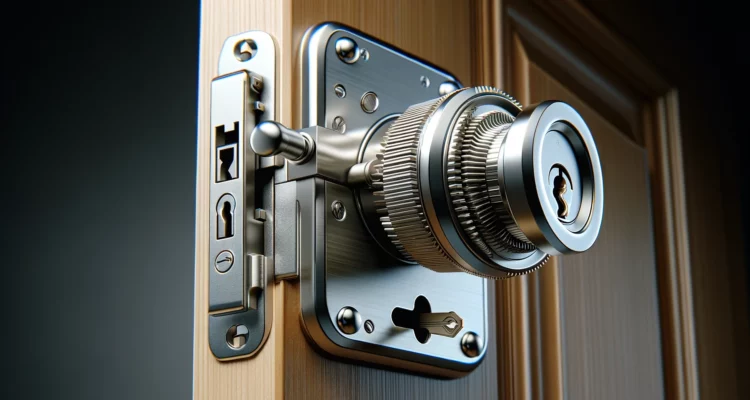The Pimlico Key Home Security Inspection
Imagine feeling a sense of unbreakable safety every time you turn the key to your front door, knowing that your home is a fortress of peace for you and your loved ones. Our “Home Security Inspection offers you just that – an expertly crafted path to securing your sanctuary against any threat.
With a sharp focus on understanding the ins and outs of your personal space, this inspection emphasizes the importance of not just the physical security measures like alarms and locks, but also the comfort and lifestyle enhancements that come with modern, innovative solutions.
Prepare to transform your home into a haven of safety, where every corner is scrutinized for potential risks, and every vulnerability is fortified with proactive, personalized strategies. This guide doesn’t just aim to protect; it seeks to empower you with knowledge and tools, ensuring your peace of mind is always secured.
Setting the Stage
Understanding the importance of a comprehensive security check
Home security is more than just locks on doors; it’s about creating a protective bubble around your family and possessions. A comprehensive security check dives deep into all aspects of your home’s safety, from the strength of your windows to the routines that may inadvertently put you at risk. It offers the peace of mind that comes from knowing every conceivable threat has been identified and can be addressed.
Setting realistic expectations and goals for the inspection
It’s important to approach your home security inspection with realistic expectations. Not every vulnerability can be eliminated overnight, but identifying them is the first step to a safer home. Your goals should focus on both immediate fixes for glaring risks and long-term strategies to enhance security measures gradually.
Preparing your home for a thorough inspection
To get the most out of your home security inspection, a little preparation goes a long way. Ensure access is clear to all entry points and that rooms are tidy enough to inspect windows and external doors efficiently. Have a list of any concerns or questions ready, so nothing is overlooked during the inspection.
External Inspection: Perimeter and Property
Evaluating the security of fences and gates
The first line of defense against intrusion is your property’s perimeter. Check the condition of fences and gates for any damage or gaps that could allow easy access. Ensure locks and latches are in good working order and consider the height of your fencing—is it enough to deter someone from attempting to climb over?
Inspecting exterior lighting for adequate coverage
Good lighting is a powerful deterrent to would-be intruders. Walk around your property after dark to see if lighting adequately covers entry points and dark corners. Pay special attention to areas that are completely shadowed, as these can provide cover for someone attempting to break in.
Assessing the condition and security of outbuildings and garages
Garages and outbuildings can provide easy access to your home if not properly secured. Check that doors and windows lock securely and that there’s no excessive wear or damage that could make them vulnerable to forced entry.
Analyzing landscaping and its impact on home security
Landscaping can play a significant role in home security. Large bushes or trees near windows can provide cover for intruders and should be trimmed back. Consider the placement of plants and decorations to ensure they do not provide hiding spots or assist in climbing.
Securing Entry Points
Checking the integrity and locks of external doors
Your external doors are a crucial barrier to entry. Ensure that they are solid, without weak spots, and that the frames are secure. Locks should be of high quality—consider deadbolts for added security.
Examining windows for security vulnerabilities
Windows can be an attractive entry point for burglars. Check for locks on all windows, and consider adding window bars or security film to those that are particularly vulnerable.
Evaluating the strength of garage doors
Garage doors should be sturdy and include a lockable mechanism. If your garage is attached to your home, its security is as important as that of your front door.
Assessing the security of pet doors and mail slots
Large pet doors and mail slots can be manipulated by intruders to gain entry into your home. Assess their size and location, and if necessary, look for secure alternatives that limit this risk.
Internal Security Measures
Inspecting the condition and placement of smoke detectors and carbon monoxide alarms
Smoke detectors and carbon monoxide alarms are vital for your safety in emergency situations. Ensure they are in good working order and placed strategically throughout your home for optimal coverage.
Evaluating existing alarm systems
If you have an alarm system, review its features and coverage. Is it monitored, and does it meet your current security needs? Regular evaluations are essential to ensure its effectiveness.
Analyzing the effectiveness of internal locks and safety devices
Examine the internal locks on doors and windows. Consider whether the addition of safety devices such as chain locks or bars could enhance your security, especially for ground-floor rooms.
Assessing the use and security of safes or secure cabinets for valuables
Valuables and important documents should be kept in a secure location. A safe or secure cabinet can offer protection against both theft and fire—consider investing in one if you haven’t already.
Leveraging Technology for Enhanced Security
Exploring smart locks and keyless entry options
Smart locks and keyless entry systems offer a high level of convenience and security. Explore options that allow you to control access to your home remotely and provide temporary access codes for visitors.
Evaluating surveillance camera systems and their coverage
Surveillance cameras can act as a powerful deterrent to criminals and provide valuable evidence in the event of a crime. Assess the coverage of your existing system or consider where cameras could be strategically placed for optimal surveillance.
Understanding home automation systems and their security benefits
Home automation systems can integrate various security features, from automated lighting to alarm systems. Understanding how these systems can enhance your home security might offer you ways to upgrade your protection with technology.
The role of motion sensors in home security
Motion sensors can alert you to movement in and around your property, providing an early warning of potential intruders. Evaluate the placement and sensitivity of existing sensors and consider areas where adding sensors could improve security.
Lighting as a Deterrent
Assessing the effectiveness of current outdoor lighting
Well-placed outdoor lighting can make your home a less attractive target for burglars. Review the effectiveness of your current setup and consider upgrades or adjustments to increase coverage.
The impact of motion-activated lights on security
Motion-activated lights can surprise and deter intruders while providing light as you or your family members come and go. Assess potential locations for motion-activated lights to enhance your security.
Strategic placement of indoor lighting to simulate occupancy
Timers and smart lights can simulate occupancy when you’re not home, deterring potential burglars. Plan the placement of these lights to create a convincing impression of activity within the house.
Considering energy-efficient security lighting options
Energy-efficient lighting options such as LED bulbs are not only good for the environment but can also reduce the costs associated with running your security lighting. Consider upgrading to more efficient options.
Personal and Behavioral Security Measures
The importance of routine security checks
Regularly conducting security checks ensures that you remain vigilant to potential vulnerabilities. Make it a routine to inspect locks, alarms, and lighting to keep your home secure.
Educating household members on security protocols
Ensuring that all household members are informed about security protocols is crucial. Discuss what to do in various scenarios and ensure everyone knows how to operate alarm systems and lock doors properly.
Practices for managing and securing spare keys
Avoid leaving spare keys in predictable places. Instead, consider a lockbox or entrusting a neighbor with a spare. Managing spare keys securely is an easy yet crucial step in maintaining your home’s security.
The role of social media in home security
Be cautious about what you share on social media. Broadcasting your location or times you’re away from home can inadvertently provide information to potential burglars. Consider privacy settings and who you’re sharing your updates with.
Neighborhood and Community Safety
Engaging with neighborhood watch programs
Neighborhood watch programs can significantly enhance community safety. Engage with local programs to stay informed about security concerns and work together to increase vigilance.
Understanding the impact of local crime rates on home security
Awareness of local crime rates can guide your home security measures. Stay informed through local news or police reports and adjust your home security strategies accordingly.
Leveraging community resources for improved security
Many communities offer resources for home security, from informational workshops to free security audits. Take advantage of these resources to bolster your home’s defenses.
Building relationships with local law enforcement for enhanced safety
Establishing a relationship with local law enforcement can provide you with additional insights into securing your home. They can offer specific advice and inform you about common threats in your area.
Post-Inspection Action Plan
Prioritizing security upgrades and fixes
After a thorough inspection, prioritize actions based on their importance and feasibility. Address the most critical vulnerabilities first, and then work through your list as time and budget allow.
Creating a timeline for implementing recommended changes
Develop a realistic timeline for making the recommended changes. Breaking it down into manageable steps can make the process less overwhelming and ensure consistent progress.
Considering budget and cost-effective security solutions
Security upgrades don’t have to break the bank. Consider cost-effective solutions and DIY options that can significantly enhance your home’s security without a large investment.
Scheduling follow-up inspections to ensure continued security
Security needs can evolve over time. Schedule regular follow-up inspections to adapt to changing circumstances and ensure your home remains a safe haven.
Advanced Security Considerations
Exploring options for off-site monitoring services
Off-site monitoring can provide an additional layer of security, offering peace of mind when you’re away from home. Explore options and consider the benefits of having professionals monitor your security systems.
The benefits of integrating AI and machine learning in home security systems
AI and machine learning can enhance home security by identifying patterns and unusual activity. Explore how these technologies can be integrated into your security system for more sophisticated protection.
Considering the need for cybersecurity measures for smart homes
As homes become smarter, they also become targets for cyber-attacks. Ensure your home network is secure, and consider cybersecurity measures to protect your smart home devices.
Assessing the viability of biometric security systems
Biometric security systems, using fingerprints or facial recognition, offer a high level of security. Consider whether these advanced systems could provide the enhanced security you’re looking for.
Through a comprehensive home security inspection, you can fortify your home against a wide range of threats. By addressing vulnerabilities, leveraging technology, and adopting proactive security measures, you’ll create a safer and more secure environment for you and your loved ones. Remember, home security is an ongoing process, demanding vigilance and regular assessment to protect against evolving risks. Take action today to secure your peace of mind for tomorrow.




